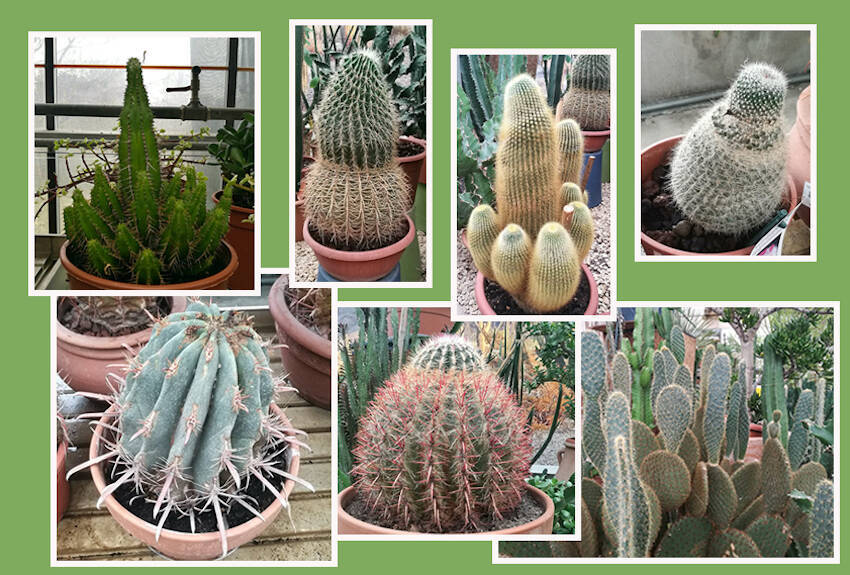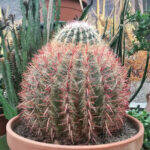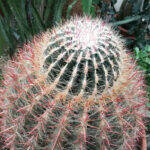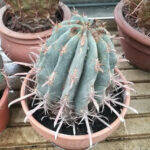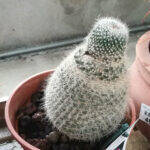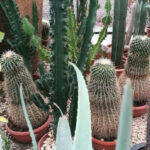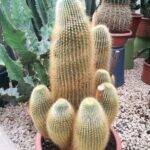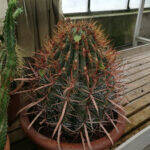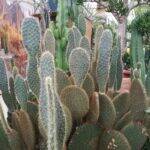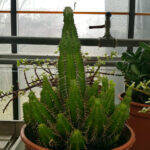An etiolated cactus is a plant with an unnatural habit and which has suffered from a more or less serious lack of light. The phenomenon is unfortunately irreversible but it is possible to prevent etiolation and stop it.
Who hasn’t happened at least once to observe in some office, apartment or even non-specialized nurseries (or garden) those cone-shaped cacti with thin spines and pale green stem? Cacti with a rounded base and an elongated apex, tapered to the point of giving the plant an almost pyramidal shape. The novice grower may think that is the normal bearing of the plant, but the grower with some experience – or even just a critical mind – usually is horrified at such plants. If anything, he or she may be saddened, because he or she knows full well that that is not the normal bearing of the cacti at all, but simply the outcome of what is technically called “etiolation” or, commonly, “spinning.” By the way, the photos above and those accompanying this article are of plants in a nursery and not mine, I want to make that clear right away!
Why does this fate happen to some cacti? How to avoid cactus etiolation and how to distinguish it from normal growth or from growth that is simply dissimilar to normal? Is it possible to remedy the damage caused by spinning on a cactus? We answer these questions in the following article. (…)
Let us first clarify that cactus etiolation is a phenomenon that affects not only cacti, but all botanical families. If anything, the problem with cacti is that it is generally an arrestable but, unfortunately, irreversible process. If in leafy plants, shrubs and trees in general it’s indeed possible to remedy by perhaps even drastically pruning the “spindly” branches, in cacti there is little that can be done to restore the plant to its original state. The reason is obvious: cacti develop through single or at most suckered and only rarely branched bodies (think of some candelabra-like cereus), but on the whole the shape of the stem is the shape of the plant, is its appearance. It is one and the same in short. That’s why effectively remedying etiolation is very difficult: you can bring the plant back to an acceptable condition, but if the phenomenon has affected drastically, returning to the original form will be impossible. I will discuss this in more detail later.
Definition of etiolation in cacti and succulent plants
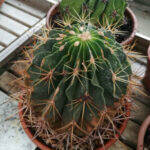
Let us first see what exactly is meant by the term “etiolation” from a botanical point of view. A brief but at the same time comprehensive answer can be found in the easy-to-read booklet, “Conoscere e coltivare le piante succulente” (“Knowing and Growing Succulent Plants“) published by the Italian Succulent Plant Lovers Association (Rome, November 30, 2005), which defines this phenomenon as follows: “Physiological process that occurs in plants when they are in a condition of insufficient light, consisting in an elongation and thinning of stems and branches that thus increase the surface area suitable for photosynthesis“. The first basic clue is that this is a physiological process, thus in some ways “natural.” Natural in a relative sense, since it’s a plant response to suboptimal (in not wrong) growing conditions. In fact, the definition goes on saying that etiolation occurs when plants are in “an insufficient light condition“. So the real cause of this phenomenon is the lack of light. Plants “spin,” as it is commonly said, not when they are in an inadequate substrate or when they are watered too frequently or infrequently or when they are over – or under- fertilized. Plants go into etiolation when they do not get enough light.
However, this concept is also relative and should be commensurate with the needs of the plant. It’s well known that there are plants that can survive only with limited exposure, filtered by other plants. Think of orchids, which do not tolerate direct sun because they are plants native to tropical or subtropical areas and thrive leaning against the branches of trees and shrubs whose foliage shields them from direct sunlight. There are plants that grow perfectly well in half-shade, that is, with bright light for only a few hours, and plants that grow well only when invested with maximum sunlight throughout the day. And this is the case with most cacti, which thrive in semi-desert areas, often in areas where there is little or almost no vegetation. At most, some cacti receive shelter from rocks or shrubs or, in the case of seedlings, from the shade cast by the mother plant. Even in these cases, however, the light they can benefit from is intense and lasts from dawn to dusk. Of course, there are also many cacti that do not tolerate direct sun and grow only under the shelter of boulders and leafy plants, as in the case of the Epiphyllums that live in rainforests and in the case of the “Christmas Cactus” (Schlumbergera) .
Having clarified this first fundamental aspect, the second part of the description helps us understand what the effects of etiolation are and why they occur. Etiolation involves an “elongation and thinning of stems and branches that thereby increase the surface area suitable for photosynthesis“. In other words, plants go in search of light, just as we would go to grasp a distant object: we stretch, we make an effort. The difference is that human beings have a limit and can stretch only within precise physical boundaries (except moving through space simply by walking!), then returning to their original posture once the effort is made. Plants do not have this limit and can elongate far beyond their original status, but they pay a very steep price, which is precisely etiolation, an irreversible process involving the permanent deformation of the plant itself. Branches or stems grow out of all proportion – desperate for the light they hope to find beyond the area of shade in which they find themselves – and once the effort is made they remain deformed, elongated, thinned, with the result that the plant loses its compact and orderly appearance. In other words, it loses its natural look.
Etiolation in cacti, how it occurs
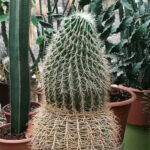
Calming the above definition to the world of cacti, we can add that etiolation is always accompanied by discoloration of the stem, which turns from dark green or bright green to light green. In leafy plants this phenomenon affects the leaves themselves, which turn yellow. Whether stems or leaves, discoloration is always due to the deficiency of chlorophyll, which is produced, as everyone knows, by photosynthesis, that is, with the help of sunlight. In very severe cases, as in many of those you see in the photos accompanying this article, the shape of the stem can alter to the point where a globular bearing cactus (e.g., Echinocactus grusonii) takes on a columnar habit with the apex rising in height while shrinking more and more. For those who are not familiar with cacti, the result may not raise particular questions (although from the point of view of aesthetics there would still be quite a lot to say), but those who have the slightest familiarity with cacti cannot help but be horrified at such compromised specimens. In cacti, moreover, etiolation greatly affects the formation of new spines, which grow much thinner in the “spun” part than they should. Indeed, in cases of severe etiolation the spines are almost insubstantial and sparser than normal.
Etiolation or abnormal growth of the plant?
In severe cases, etiolation of cacti is very easy to recognize. Unless you have no knowledge of this botanical family, it will immediately appear abnormal if the plant has a spun, discolored, thornless apex. If you see it in a nursery, forget about it: it would be a wrong purchase since there is no way back, from an aesthetic point of view. The principle of cactus etiolation, on the other hand, may not appear so obvious. At least not to the experienced grower. We take a good look at the plants, and if we have doubts about their shape, we look online for photos of those same plants in habitat. This will be enough to give us an idea of the correct habit that that plant should have: globular, columnar, branched, tufted, etc. Unmistakable clues to a principle of etiolation are discoloration of the stem apex, which may appear pale green, and the absence of new spines (or the formation of spines that are significantly thinner than they should be). In these cases the plant is beginning to spin and is telling us that it desperately needs light. Be careful, however: let’s not move it into direct sun right away, because the apex of the plant is delicate, especially if it is beginning to etiolate, and we would only burn it. We move the plant to a brighter place for a few weeks, then, if it is a cactus that wants direct sun, we can move it outdoors.
The novice grower may find it difficult to distinguish between true etiolation, abnormal growth or even regular growth. In fact, it may happen that a cactacea with a globular habit grows in height. This is not always a sign of etiolation. Let’s take a close look at the plant: if the stem has no narrowing in the direction of the apex, if the spines are uniform, if the plant has no bottlenecks or discoloration, this is not etiolation but an abnormal growth. This can be due to several factors: first, we have to consider that over the years many cacti tend to become brevicylindrical from globose. They also do this in habitat and it’s normal: many Ferocactus and Echinocatus have this “habit” as do Euphorbia obesa.
Cactus and succulent plants: a guide to identification and classification.
If, however, we are not dealing with large or aged specimens, then it will be abnormal growth due to other factors. Excluding genetics, which we cannot investigate and intervene on, growing factors are irrigation, fertilization, temperature, and substrate. Overfertilization can easily alter the bearing of any plant, as the use of an unsuitable substrate. Also the exposure, even if not insufficient to the point of causing etiolation, may not be adequate, leading that plant to grow differently than Nature intended. By restoring proper growing conditions, we are unlikely to cause the abnormally grown plant to resume a right look, but if nothing else, we will encourage new and proper growth.
What to do against cactus etiolation
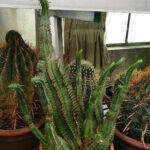
Once we have determined that there’s a principle of etiolation or that our plant has been etiolated for some time, we can take corrective action. Beware, however: as I have written, unfortunately there’s no going back, and the etiolated part will remain forever. If we have a branching succulent plant we can prune off the etiolated branches or pull off the yellowed or elongated leaves, but if the etiolation concerns a cactacea… we have to surrender to the evidence and engage us at least to bring the plant back to proper developmental condition. It’s not rare that with time and new growth the etiolated part will become less noticeable, and the plant will react in a surprising way, taking on a bearing that is indeed abnormal but interesting and aesthetically pleasing. This is what happened to the Echinocactus grusonii that I discuss at the end of this article. In any case, once we identify etiolation or the principle of etiolation in a cactacea, all we can do is try to improve the light conditions by gradually moving it. Never put a plant (etiolated or not) in full sun if that plant is not used to direct light: we only expose it to the risk of severe sunburn. We need to read up on the type of plant (e.g., Cactacea or Euphorbia?), figure out what its light requirements are (direct or filtered sun?) and arrive at the correct exposure in stages. While we re-accustom the plant to the right light intensity, we must reduce watering and suspend fertilization. We also postpone repotting so as to avoid further stress to the plant at this delicate stage.
If the plant is healthy and if we can give it the correct amount of light (not only in terms of intensity, but also in terms of hours of sunlight), we are able to stop the etiolation process. At that stage, patience is necessary: the plant resumes growing properly, enlarge the apex, which regains its correct coloring, and forms new spines in line with the old ones, that is, stronger and thicker. In other words, the apex returns to normal, and if we look at the plant from above, we don’t see anything abnormal. If we look at it from the side, we can observe the enlarged base, then the bottleneck in correspondence with the etiolation period, and finally the new growth. The effect, in most cases, is that of an “hourglass”, but if we have nipped the etiolation in the bud, there is a chance that the aesthetic damage becomes less and less visible over time.
Finally, we have to consider an important factor: a “spartan” cultivation, in short, that tries to imitate as much as possible the conditions in which cacti are found in their habitat, can only fortify the plants, slow down the growth rates and, at the same time, prevent etiolation of the stems by contributing to the maintenance of the correct and compact form that these plants have.
Beware of winter: should I bring succulents inside?
For those who grow cacti and succulents correctly, placing them in the proper place during the growing season, winter is he only period at risk of etiolation. Not everyone is fortunate enough to have a greenhouse, and even those who have a garden or a large terrace are forced to shelter cacti and succulents as best they can in winter, particularly in areas of northern Italy. Many resort to the stairwell, others use garages or other cold rooms. Some growers use mountable greenhouses or repair plants with layers of nonwoven fabric. In all these cases, if you stop watering altogether from the end of September and if the plants experience a consistent drop in temperatures, there are no problems. This is because under these conditions succulents stop vegetating and stunt new growth while waiting for spring.
If, on the contrary, succulents do not go into stasis, for example because you continue to water while keeping the plants in a heated place or at least at minimum temperatures of not less than 10 Celsius degrees, the risk of etiolation is real. This happen also because one of the first rules for growing cacti (I mean most of the species) involves avoiding “indoor” cultivation, that is, in an apartment. Even if placed on a south-facing windowsill, cacti will never get enough light and especially not for the amount of hours they need for proper growth. While this is true at any season of the year, it’s more true in winter, when the incidence of sunlight is very low and the hours of light are drastically reduced. If we do not stunt growth, in such low light conditions the plant will only continue to vegetate by etiolating, that is, by going in search of light. It is for this reason (as well as to encourage blooms) that it is essential to overwinter cacti and many succulents in the cold. Beware of exceptions, of course: tropical succulents and some genera of cacti do not tolerate too low a minimum (e.g., Melocactus, Discocactus, Schlumbergera). In these cases we can keep the plants indoors, watering no more than once a month just to contain growth.
If we don’t have an unheated place to shelter the plants, we are forced to take them to the apartment. In these cases, we try to place them in the least heated and most lighted room and still suspend watering so as to push the plants to an abrupt slowdown in growth. Finally, let’s keep in mind an important element: if we stop vegetation altogether by keeping the plants in the cold (for example, with lows around 5 Celsius degrees) and suspending watering, the importance of light is relative and we are able to keep cacti and succulents, in winter, even in dimly lit places without running the risk of etiolation. The ideal solution (I realize that this is not always possible) is not to move the plants, that is, to keep them where we grow them in the growing season, i.e., a balcony, a terrace, a greenhouse, while sheltering them from the cold and rain in the fall and winter months (e.g., with layers of nonwoven fabric or with canopies). In this way the plants will follow natural light cycles, enjoy the right temperatures, and fortify themselves while avoiding the risk of etiolation altogether.
Incidentally: it’s for reasons such as those I have outlined above that very often, in non-generic nurseries, we see cacti and succulents terribly spindled, as in the photos I took in recent days in a nursery and publish in this article. There is a tendency in nurseries to try to keep plants always “bloated” and palatable for sale, watering them year-round and sheltering them with overly dense shade nets (necessary for other, more delicate plant families and perhaps kept on the same benches).
Abnormal reactions to etiolation in cacti
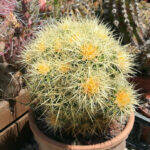
In some cases, following etiolation, cacti may react abnormally when restored to optimal conditions for recovery. This is what happened to the Echinocactus grusonii you see in the photo here. The plant, with its typical globular habit, was given to me four years ago. It was kept for at least a couple of years on an office window sill by the previous owner, in inadequate light conditions. When it was given to me it was in very poor condition: the base was rounded and with spines of correct consistency, but the lack of light had caused the apex to grow tall, taking on the characteristic cone shape of heavily etiolated cacti. The apical part was also pale green and virtually spineless: it had only the hint of a few very thin and sparse spines. In short, a disaster. I took the plant to “save” it and, without repotting it, took it to the greenhouse, in a corner sheltered from direct sun. The Echinocactus stayed in that corner for a whole year, receiving very little watering. In this way I began to accustom the plant to brighter light.
After the first year, when I saw that the apex had begun to regain its proper deep green color, I moved the plant outside to half shade. The cactus received direct light only in the early morning hours and then switched to shade. During the second year, the thorns resumed growing properly, but the plant did something that cacti usually do following a damage to the apex (such as from a bump or some insect bite): it began suckering profusely. The apex became covered with suckers, i.e., new heads with strong, long, golden-yellow spines.
Since the plant suckered, I always kept it outdoors from March through September, watering at most once a month if it was not raining. The result, about four years later, is what you see in the photo. When viewed from above, the plant shows no signs of etiolation and has a very interesting shape, with numerous suckers and beautiful spines. If you look at it from the side you can still see the elongated stem, but with time and the development of suckers I am sure that the damage will almost completely disappear and the Echinocactus will become unique, i.e. heavily suckered and definitely beautiful, harmonious in its new form.
A few photographs of cactus etiolation
Below is a gallery of pictures of heavily etiolated Cactaceae and Euphorbiaceae. The photos were taken at a nursery not specialized in succulent plants. Click on the image to enlarge it.
SUBSCRIBE TO THE SITE – If you liked this article, subscribe to the site to have access to all the contents for one year or three months depending on the formula you choose. Here you will find terms and conditions.
SUBSCRIBE TO THE NEWSLETTER – If you want to receive the free newsletter every time new content is published (even if you have not subscribed to the site), fill in the fields at this link!
Correlated articles
How much light do cactus need? A summary table
How to repot cacti and succulent plants
Substrates for cacti and succulents
The correct soil: the materials you can use
When and how fertilize cactus and succulent plants
© The texts, videos, photos and graphic elaborations of the site “Il fiore tra le spine” are original material and are covered by copyright. It’s forbidden to reproduce them in any way.


